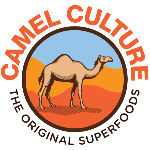Why Camel Milk is the Original Superfood
The term "superfood" was first used in the 20th century to market the latest health food trends like kale, acai bowls, and avocados.
But trends come and go! Imagine if we were still walking around in wide-collar shirts and platform shoes dancing to Saturday Night Fever.
We need to pay attention to ancient ancestral wisdom. Not just isolated to a particular culture, but global! What has survived the ultimate test -the test of time?
How Long Have People Been Drinking Camel Milk?
Camel Milk is a health food secret (at least in the USA). But in places like the Arabian Peninsula, North Africa, and the Horn of Africa, the secret has been out for thousands of years!
How long have people been drinking camel milk? Thousands of years! In the Arabian Peninsula, people started drinking camel milk around 3,000 BC. That's right, people have been drinking camel milk for at least 5,000 years! This ancestral superfood has sustained pastoral cultures for millennia, and the best things always stand the test of time.
Camels are the Ultimate Survivors
Camels have not only stood the test of time, they have also survived the harshest environments on planet earth. If you've traveled to any desert, you've probably noticed that not much is living there. Only the strong survive! Camels have not only survived but thrived in these desert environments. These massive, beautiful animals are biological miracles of mother nature.
They can survive weeks without food or water. One common misconception is that the camel hump is filled with water, but it's actually filled with fat. This hump acts as a reserve of food storage, metabolizing into energy when they need it, and allowing them to go months without food.

The Sahara Desert, famous for its dromedary camels, is the largest desert on planet earth. It can reach temperatures over 120 degrees Fahrenheit and low temperatures of below freezing (20 degrees Fahrenheit).
We source our camel milk locally here in the USA, and people often ask us, "Don't the camels get cold here?" No, camels are the ultimate adapters. They can thrive in extreme heat as well as extreme cold.
I grew up in the midwest, but during my first trip to the Sahara Desert in 2013, I was shocked by how cold it got at night! All I packed was a sweatshirt and I was freezing at night.
Camels Have a Low Environmental Impact
In the desert, there are limited resources, so camels have adapted to thrive on very little. Because camels can survive with relatively little water and plant life for long periods of time, they consume far less resources than other grazing animals such as a cow or buffalo.
So camels have a smaller environmental footprint because they need less area for grazing and feeding. They are highly efficient animals -nothing is wasted! It's no wonder camel milk is such a nutrient dense superfood!
Valued in Desert Cultures
People living in the Middle East and Africa have been living on camel milk for centuries. There is a Somali proverb that says, “a mouthful of camel's milk keeps you going for half-a-day.”
Nomads in East Africa survive on long journeys only drinking camel milk. They consume the milk for nourishment, but not only that, camel milk is also used as a natural remedy for everything from sunscreen to cancer treatment.
These animals are essential to allowing humans to live sustainably in the desert.

Camels are only valued for their milk, they are also a source of food, transportation, and even currency. Camels can walk 100 miles a day carrying a rider -earning them the nickname "the ships of the desert". And wealth is often measured by the size of their herd. As one nomad told me, "camels are like our $100 bills, while sheep and goals are our small coins."
Health Benefits of Camel Milk
1. Similar Protein Structure to Human Breast Milk:
Camel milk is the closest animal dairy to human mother's milk!
Camels produce a heathy milk full of rare proteins which boost your body's natural immune system. Similar to an infant who relies on a natural immunity they receive from their mother's milk.
2. Non-Allergenic:
Many people today are suffering for food allergies -especially when it comes to cow milk. Cow milk allergy is the most common food allergy in babies and young children.
Camel milk lacks the 2 most common allergenic proteins found in cow milk -A1 casein and lactoglobulin, and it is usually tolerated by those with dairy allergies.
3. Rich in Vitamins and Nutrients:
Camel milk contains 10x more iron and 3x more vitamin C than cows milk. It's also higher than cows milk in calcium, potassium, and vitamin A, B, D, E.
All while being low in cholesterol and saturated fat -and high in healthy unsaturated fatty acids.
Try Camel Milk for Yourself!
The only way to discover the power of camel milk is to give it a try! If it can sustain on a 1,000 mile journey through 120 degree heat -imagine how it can benefit you.
We offer a risk-free sample pack to get you over the hump and calm your nerves about drinking milk that does not come from a cow!

It's time to ditch the latest superfood trends and get back to the original superfood -camel milk! Trust the wisdom of our nomadic ancestors, who have proven over millennia that camel milk is the milk that gives life!



